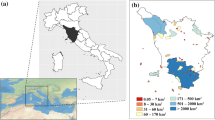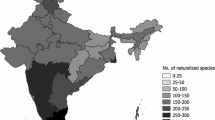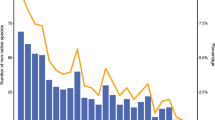Abstract
The main aim of this paper is to assess the drivers of non-native plant species richness and composition on a set of 37 small Mediterranean islands in Italy. We compiled the list of the non-native flora and distinguished species according to their establishment status. The non-native flora of the islands studied consists of 154 species, 105 of which are established on at least one island. Regression tree analysis revealed that the main determinants of both total non-native and established non-native species richness are the variables linked to tourist development and the sprawl of artificial surfaces. The variation partitioning approach shows that the variation in total non-native flora composition is driven above all by environmental variables, whereas when established taxa are considered, human-mediated factors account for most of the explained variation. Mediterranean islands have recently experienced changes in the type and intensity of human activities, leading to a decline in rural landscape and the development of tourist facilities. Our results indicate that tourism and the increase in the extension of artificial surfaces are also the main drivers of non-native plant species occurrence and establishment. These factors outweigh the effects of abiotic variables such as climate and lithology in determining the number of non-native species, whether it be total or established, as well as variations in the composition of established species. High human pressure and ornamental introductions associated with tourist activities appear to be the key elements that need to be considered when planning strategies aimed at managing plant invasions in Mediterranean islands.


Similar content being viewed by others
References
Affre L, Suehs CM, Charpentier S, Vilà M, Brundu G, Lambdon P, Traverset A, Hulme PE (2010) Consistency in the habitat degree of invasion for three invasive plant species across Mediterranean islands. Biol Invasions 12(8):2537–2548
Blondel J, Aronson J, Bodiou JI, Boeuf G (2010) The Mediterranean Region. Biological diversity in space and time. Oxford University Press, Oxford
Borcard D, Legendre P, Drapeau P (1992) Partialling out the spatial component of ecological variation. Ecology 73:1045–1055
Botham MS, Rothery P, Hulme PE, Hill MO, Preston CD, Roy DB (2009) Do urban areas act as foci for the spread of alien plant species? An assessment of temporal trends in the UK. Divers Distrib 15:338–345
Bourgeois K, Suehs CM, Vidal E, Médail F (2005) Invasional meltdown potential: facilitation between introduced plants and mammals on French Mediterranean islands. Ecoscience 12:248–256
Carboni M, Santoro R, Acosta A (2010a) Are some communities of the coastal dune zonation more susceptible to alien plant invasions? J Plant Ecol 3(2):139–147
Carboni M, Thuiller W, Izzi F, Acosta A (2010b) Disentangling the relative effects of environmental versus human factors on the abundance of native and alien plant species in Mediterranean sandy shores. Divers Distrib 16:537–546
Castro SA, Jaksic FM (2008) Role of non-established plants in determining biotic homogeneization patterns in Pacific Oceanic Islands. Biol Invasions 10:1299–1309
Castro SA, Daelher CC, Silva L, Torres-Santana CW, Reyes-Betancort JA, Atkinson R, Jaramillo P, Guezou A, Jaksic FM (2010) Floristic homogeneization as a teleconnected trend in oceanic islands. Divers Distrib 16:902–910
Celesti-Grapow L, Pyšek P, Jarošík V, Blasi C (2004) Determinants of native and alien species richness in the urban flora of Rome. Divers Distrib 12:490–501
Celesti-Grapow L, Alessandrini A, Arrigoni PV, Banfi E, Bernardo L, Bovio M, Brundu G, Cagiotti M, Camarda I, Carli E, Conti F, Fascetti S, Galasso G, Gubellini L, La Valva V, Lucchese F, Marchiori S, Mazzola P, Peccenini S, Poldini L, Pretto F, Prosser F, Siniscalco C, Villani MC, Viegi L, Wilhalm T, Blasi C (2009) The inventory of the non-native flora of Italy. Plant Biosyst 143:386–430
Celesti-Grapow L, Alessandrini A, Arrigoni PV, Assini S, Banfi E, Barni E, Bovio M, Brundu G, Cagiotti M, Camarda I, Carli E, Conti F, Del Guacchio E, Domina G, Fascetti S, Galasso G, Gubellini L, Lucchese F, Medagli P, Passalacqua N, Peccenini S, Poldini L, Pretto F, Prosser F, Vidali M, Villani MC, Viegi L, Wilhalm T, Blasi C (2010) Non native flora of Italy: distribution and threats. Plant Biosyst 144:12–28
Chytrý M, Maskell LC, Pino J, Pyšek P, Vilà M, Font X, Smart SM (2008) Habitat invasions by alien plants: a quantitative comparison among Mediterranean, subcontinental and oceanic regions of Europe. J Appl Ecol 45:448–458
Colautti RI, Grigorovich IA, MacIsaac HJ (2006) Propagule pressure: a null model for biological invasions. Biol Invasions 8:1023–1037
De’ath G, Fabricius KE (2000) Classification and regression trees: a powerful yet simple technique for ecological data analysis. Ecology 81:3178–3192
Dehnen-Schmutz K, Touza J, Perrings C, Williamson M (2007) A century of the ornamental plant trade and its impact on invasion success. Divers Distrib 13:527–534
Duarte MC, Rego F, Moreira I (2005) Distribution patterns of plant communities on Santiago Island, Cape Verde. J Veg Sci 163:283–292
Essl F, Dullinger S, Rabitsch W, Hulme PE, Hülber K, Jarošík V, Kleinbauer I, Hülber K, Jarošík V, Kleinbauer I, Krausmann F, Kühn I, Nentwig W, Vilà M, Genovesi P, Gherardi F, Desprez-Loustau M-L, Roques A, Pyšek P (2011) Socioeconomic legacy yields an invasion debt. Proc Natl Acad Sci USA 108:203–207
Ficetola GF, Padoa-Schioppa E (2009) Human activities alter biogeographical patterns of reptiles on Mediterranean islands. Global Ecol Biogeogr 18:214–222
Gritti ES, Smith B, Sykes MT (2006) Vulnerability of Mediterranean Basin ecosystems to climate change and invasion by exotic plant species. J Biogeogr 33:145–157
Grove AT, Rackam O (2001) The Nature of Mediterranean Europe. An ecological history. Yale University Press, New Haven
Heatwole H, Walker TA (1989) Dispersal of alien plants to coral cays. Ecology 70:787–790
Hess AL (1990) Overview: sustainable development and environmental management of small islands. In: Beller W, d’Ayala P, Hein P (eds) Man and the biosphere 5: sustainable development and environmental management of small islands. UNESCO, Paris, pp 3–14
Hulme PH, Brundu G, Camarda I, Dalia P, Lambdon P, Lloret F, Medail F, Moragues E, Suehs C, Traverset A, Troumbis A, Vilà M. (2008) Assessing the risks to Mediterranean islands ecosystems from alien plant introductions. In: Tokarska-Guzik B, Brock JH, Brundu G, Child L., Daehler CC, Pyšek P (eds) Plant invasions: human perception, ecological impacts and management. Backhuys Publishers, Leiden, pp 39–56
Kallimanis AS, Bergmeier E, Panitsa M, Georghiou K, Delipetrou P, Dimopulos P (2010) Biogeographical determinants for total and endemic species richness in a continental archipelago. Biodivers Conserv 19:1225–1235
Kreft H, Jetz W, Mutke J, Kier G, Barthlott W (2008) Glob diversity of island floras from a macroecological perspective. Ecol Lett 11:116–127
Kueffer C, Daehler CC, Torres-Santana CW, Lavergne C, Meyer JY, Otto R, Silva L (2010) A global comparison of plant invasions on oceanic islands. Perspect Plant Ecol Evol Syst 12:145–161
La Sorte FA, McKinney ML (2007) Compositional changes over space and time along an occurrence-abundance continuum: anthropogenic homogeneization of the North American avifauna. J Biogeogr 34:2159–2167
Lambdon PW, Lloret F, Hulme PE (2008) How do introduction characteristics influence the invasion success of Mediterranean alien plants? Perspect Plant Ecol Evol Syst 10:143–159
Legendre P, Legendre L (1998) Numerical ecology. Elsevier, Amsterdam
Long JD, Trussell GC, Elliman T (2009) Linking invasion to biogeography: isolation differentially affects exotic and native plant diversity. Ecology 90:863–868
Marco A, Lavergne S, Dutoit T, Bertaudière-Montès V (2010) From the backyard to the backcountry: how ecological and biological traits explain the escape of garden plants into Mediterranean old fields. Biol Invasions 12:761–779
McKinney ML (2002) Influence of settlement time, human population, park shape and age, visitation and roads on the number of alien plant species in protected areas in the USA. Divers Distrib 8:311–318
McMaster RT (2005) Factors influencing vascular plant diversity on 22 islands off the coast of eastern North America. J Biogeogr 32:475–492
Médail F, Quézel P (1999) Biodiversity hotspots in the Mediterranean Basin: setting global conservation priorities. Conserv Biol 13:1510–1513
Moody A (2000) Analysis of plant species diversity with respect to island characteristics on the Channel Islands, California. J Biogeogr 27:711–723
Økland RH, Eilertsen O (1994) Canonical correspondence analysis with variation partitioning—some comments and an application. J Veg Sci 5:117–126
Papayannis T, Soroeou A (2008) Cultural Landscapes of Mediterranean Islands. In: Vogiatzakis IN, Pungetti G, Mannion AM (eds) Mediterranean Island Landscapes—natural and cultural approaches. Springer, London, pp 82–99
Pickering CM, Mount A, Wichmann MC, Bullock JM (2011) Estimating human-mediated dispersal of seeds within an Australian protected area. Biol Invasions 13:1869–1880
Politecnico di Milano (2005) GIS NATURA. Il GIS delle conoscenze naturalistiche in Italia. Ministero dell’Ambiente e della Tutela del Territorio, Rome. CD-ROM
Pretto F, Celesti-Grapow L, Carli E, Blasi C (2010) Influence of past land use and current human disturbance on non-native plant species on small Italian islands. Plant Ecol 210:225–239
Pyšek P, Richardson DM (2006) The biogeography of naturalization in alien plants. J Biogeogr 33:2040–2050
Pyšek P, Richardson DM, Rejmánek M, Webster G, Williamson M, Kirschner J (2004) Alien species in checklists and floras: towards better communication between taxonomists and ecologists. Taxon 53:131–143
Pyšek P, Jarošík V, Chytrý M, Kropáč Z, Tichý L, Wild J (2005) Alien plants in temperate weed communities: prehistoric and recent invaders occupy different habitats. Ecology 86:772–785
Pyšek P, Jarošík V, Pergl J, Randall R, Chytrý M, Kühn I, Tichý L, Danihelka J, Chrtek Jun J, Sádlo J (2009) The global invasion success of Central European plants is related to distribution characteristics in their native range and species traits. Divers Distrib 15:891–903
Pyšek P, Bacher S, Chytrý M, Jarošík V, Wild J, Celesti-Grapow L, Gassó N, Kenis M, Lambdon PW, Nentwig W, Pergl J, Roques A, Sádlo J, Solarz W, Vilà M, Hulme PE (2010a) Contrasting patterns in the invasions of European terrestrial and freshwater habitats by alien plants, insects and vertebrates. Glob Ecol Biogeogr 19:317–331
Pyšek P, Jarošík V, Hulme PE, Kühn I, Wild J, Arianoutsou M, Bacher S, Chiron F, Didžiulis V, Essl F, Genovesi P, Gherardi F, Hejda M, Kark S, Lambdon PW, Desprez-Loustau M, Nentwig W, Pergl J, Poboljšaj K, Rabitsch W, Roques A, Roy DB, Shirley S, Solarz W, Vilà M, Winter M (2010b) Disentangling the role of environmental and human pressures on biological invasions across Europe. Proc Natl Acad Sci USA 107:12157–12162
Reaser JK, Meyerson LA, Cronk Q, De Poorter M, Eldrege LG, Green E, Kairo M, Latasi P, Mack RN, Mauremootoo J, O’Dowd D, Orapa W, Sastroutomo S, Saunders A, Shine C, Thrainsson S, Vaiutu L (2007) Ecological and socioeconomic impacts of invasive alien species in island ecosystems. Environ Conserv 34:98–111
Rodgers JC III, Parkel KJ (2003) Distribution of alien plant species in relation to human disturbance on the Georgia Sea Islands. Divers Distrib 9:385–398
Sanz-Elorza M, Rubén GM, Bernardo FG (2009) The historical role of agriculture and gardening in the introduction of alien plants in the western Mediterranean. Plant Ecol 202:247–256
Saunders DA, Hobbs RJ, Margules CR (1991) Biological consequences of ecosystem fragmentation: a review. Conserv Biol 5:18–32
Sax DF, Gaines SD (2008) Species invasions and extinction: the future of native biodiversity on islands. Proc Natl Acad Sci USA 105:11490–11497
Stohlgren TJ, Pyšek P, Kartesz J, Nishino M, Pauchard A, Winter M, Pino J, Richardson DM, Wilson JRU, Murray BR, Phillips ML, Ming-yang L, Celesti-Grapow L, Font X (2011) Widespread plant species: natives versus aliens in our changing world. Biol Invasions 13:1931–1944
ter Braak CJF, Šmilauer P (1998) CANOCO reference manual and user’s guide to CANOCO for windows: software for canonical community ordination (Version 4). Microcomputer Power, New York
Theoharides KA, Dukes JS (2007) Plant invasion across space and time: factors affecting nonindigenous species success during four stages of invasion. New Phytol 176:256–273
Thuiller W, Richardson DM, Pyšek P, Midgley GF, Hughes GO, Rouget M (2005) Niche-based modelling as a tool for predicting the risk of alien plant invasions at a global scale. Glob Change Biol 11:2234–2250
Thuiller W, Albert C, Araújo MB, Berry PM, Cabeza M, Guisan A, Hickler T, Midgley GF, Paterson J, Schurr FM, Sykes MT, Zimmermann ME (2008) Predicting global change impacts on plant species’ distributions: future challenges. Perspect Plant Ecol Evol Syst 9:137–152
Triantis KA, Nogués-Bravo D, Hortal J, Borges PAV, Adsersen H, Fernández-Palacios JM, Araújo MB, Whittaker RJ (2008) Measurements of area and the (island) species-area relationship: new directions for an old pattern. Oikos 117:1555–1559
Tzanopoulos J, Vogiatzakis IN (2011) Processes and patterns of landscape change on a small Aegean island: the case of Sifnos, Greece. Landsc Urban Plann 99:58–64
Tzanopoulos J, Mitchley J, Pantis JD (2007) Vegetation dynamics in abandoned crop fields on a Mediterranean island: development of succession model and estimation of disturbance thresholds. Agric Ecosyst Environ 120:370–376
Underwood EC, Viers JH, Klausmeyer KR, Cox RL, Shaw MR (2009) Threats and biodiversity in the Mediterranean biome. Divers Distrib 15:188–197
Vilà M, Pujadas J (2001) Land-use and socio-economic correlates of plant invasions in European and North African countries. Biol Conserv 100:397–401
Vilà M, Pino J, Montero A, Font X (2010) Are island plant communities more invaded than their mainland counterparts? J Veg Sci 21:438–446
Von Der Lippe M, Kowarik I (2007) Long-distance dispersal of plants by vehicles as a driver of plant invasions. Conserv Biol 21:986–999
Whittaker RJ, Fernández-Palacios JM (2008) Island biogeography. Ecology, evolution and conservation. Oxford University Press, Oxford
Acknowledgments
We would like to thank the following regional experts who provided a large amount of data on the non-native flora of the Italian islands for the project “A survey of the non-native flora of Italy”, funded by the Italian Ministry for the Environment, Land and Sea Protection: Pier Virgilio Arrigoni, Ignazio Camarda, Emanuele Del Guacchio, Gianniantonio Domina, Pietro Mazzola, Simonetta Peccenini and Lucia Viegi. We are most grateful to Bruno Foggi for providing information and unpublished data on plant invasion in the Tuscan Archipelago. We also wish to thank Aldo Marchetto and Francesco Maria Sabatini for their help with the statistical analysis, as well as Sabina Burrascano, Montserrat Vilà and two anonymous reviewers whose valuable comments and suggestions improved this work.
Author information
Authors and Affiliations
Corresponding author
Rights and permissions
About this article
Cite this article
Pretto, F., Celesti-Grapow, L., Carli, E. et al. Determinants of non-native plant species richness and composition across small Mediterranean islands. Biol Invasions 14, 2559–2572 (2012). https://doi.org/10.1007/s10530-012-0252-7
Received:
Accepted:
Published:
Issue Date:
DOI: https://doi.org/10.1007/s10530-012-0252-7




